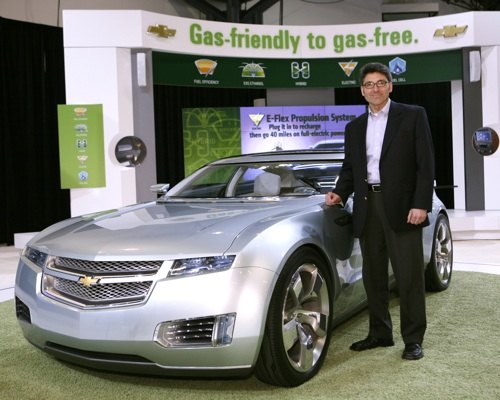Volt Birth Watch 149: "300 Miles on a Full Charge and a Full Tank"
Eddy gave us the heads-up on Chevrolet Volt Vehicle Chief Engineer Andrew Farah’s party piece over at FastLane. Straight out of the gate, Farah’s not shooting straight on the all-important question of the Volt’s effective driving range. “Scott” asks Andy to compare the Volt to the Honda Insight and Toyota Prius non-plug-in hybrids. “Clearly I enjoyed the significantly longer EV distance that is available with the Volt. I had to drive quite some distance before the engine came on, even though I didn’t start with a full charge. By comparison, our chassis is much more sporty than either of the other vehicles.” Non-starter and a non-sequitur in the same comment; nicely played. And just when you thought it was safe to sit and spin, another e-interlocutor gets Andy to spill the beans.
“What will be the approximate size of the fuel tank and maximum range?” he asks.
We’re still balancing the size of the tank with other factors, but the range will be more than 300 miles on a full charge and with a full tank of fuel.
That, it has to be said, is not a lot. And probably calculated under ideal (i.e., EPA-mandated) conditions.
Farah also has some info for potential customers blowing hot and cold on the potential effect of temperature extremes on the Volt’s range and performance. First, he hints that the Volt will match the new Prius’ solar-powered roof panel AC thingiemabob. At least that’s my take on his enigmatic promise: “We plan to give drivers some unique options when it comes to controlling there [sic] cabin comfort.” As for chilly weather compatibility:
As most people know, cold batteries cannot deliver as much power as warm batteries. The Volt is equipped with an automatic battery thermal management system that will keep them within an optimal temperature range. However, in extremely cold situations we will have to use the engine to supplement the battery.
More by Robert Farago
Latest Car Reviews
Read moreLatest Product Reviews
Read moreRecent Comments
- Lou_BC Well, I'd be impressed if this was in a ZR2. LOL
- Lou_BC This is my shocked face 😲 Hope formatting doesn't fook this up LOL
- Lou_BC Junior? Would that be a Beta Romeo?
- Lou_BC Gotta fix that formatting problem. What a pile of bullsh!t. Are longer posts costing TTAC money? FOOK
- Lou_BC 1.Honda: 6,334,825 vehicles potentially affected2.Ford: 6,152,6143.Kia America: 3,110,4474.Chrysler: 2,732,3985.General Motors: 2,021,0336.Nissan North America: 1,804,4437.Mercedes-Benz USA: 478,1738.Volkswagen Group of America: 453,7639.BMW of North America: 340,24910.Daimler Trucks North America: 261,959


































Comments
Join the conversation